brakes HONDA ACCORD HYBRID 2019 Owners Manual
[x] Cancel search | Manufacturer: HONDA, Model Year: 2019, Model line: ACCORD HYBRID, Model: HONDA ACCORD HYBRID 2019Pages: 727, PDF Size: 24.78 MB
Page 31 of 727
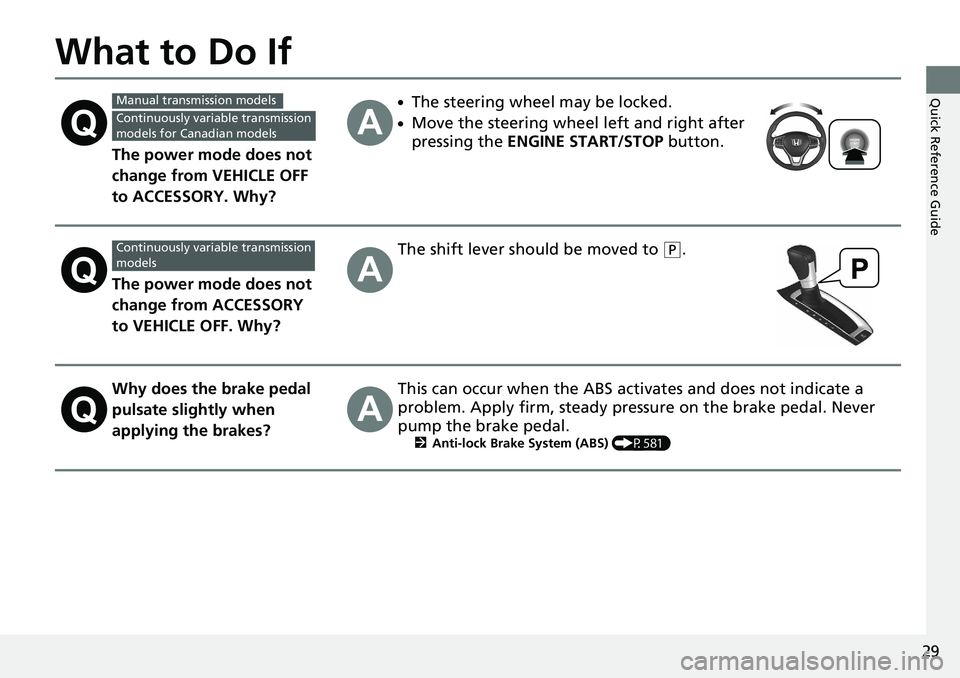
29
Quick Reference Guide
What to Do If The power mode does not
change from VEHICLE OFF
to ACCESSORY. Why? ●
The steering wheel may be locked. ●
Move the steering wheel left and right after
pressing the ENGINE START/STOP button.
The power mode does not
change from ACCESSORY
to VEHICLE OFF. Why? The shift lever should be moved to ( P
.
Why does the brake pedal
pulsate slightly when
applying the brakes? This can occur when the ABS activates and does not indicate a
problem. Apply firm, steady pressure on the brake pedal. Never
pump the brake pedal. 2 Anti-lock Brake System (ABS) (P581)Manual transmission models
Continuously variable transmission
models for Canadian models
Continuously variable transmission
models
Page 125 of 727
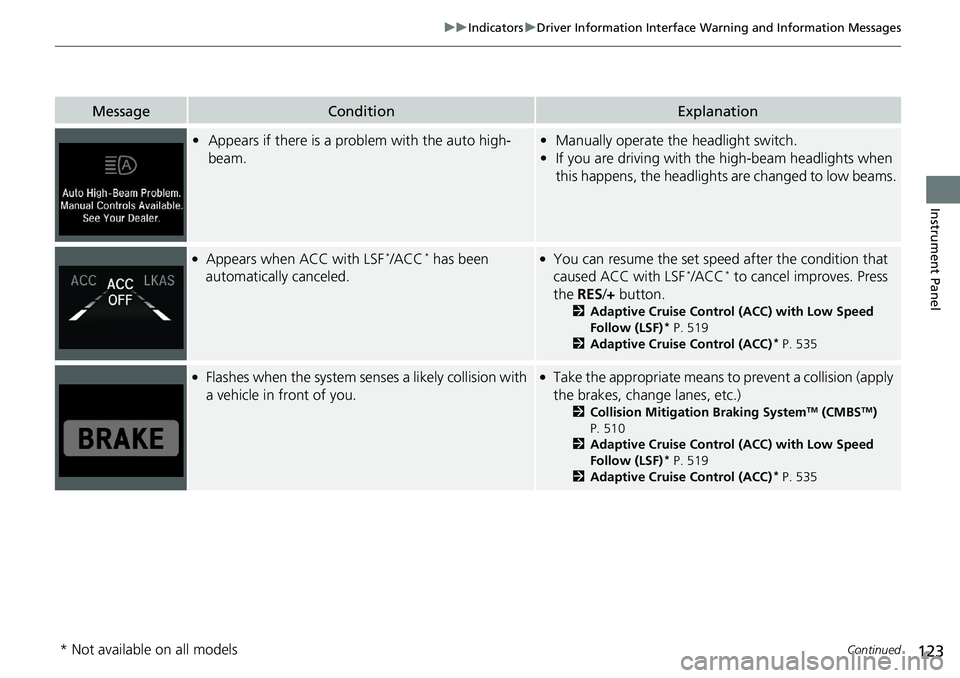
123uu Indicators u Driver Information Interface Wa rning and Information Messages
Continued
Instrument Panel
Message Condition Explanation
• Appears if there is a prob lem with the auto high-
beam. • Manually operate the headlight switch.
• If you are driving with the high-beam headlights when
this happens, the headlight s are changed to low beams.●
Appears when ACC with LSF *
/ACC *
has been
automatically canceled. ●
You can resume the set speed after the condition that
caused ACC with LSF *
/ACC *
to cancel improves. Press
the RES / + button. 2 Adaptive Cruise Control (ACC) with Low Speed
Follow (LSF) *
P. 519
2 Adaptive Cruise Control (ACC) *
P. 535●
Flashes when the system senses a likely collision with
a vehicle in front of you. ●
Take the appropriate means to prevent a collision (apply
the brakes, change lanes, etc.) 2 Collision Mitigation Braking System TM
(CMBS TM
)
P. 510
2 Adaptive Cruise Control (ACC) with Low Speed
Follow (LSF) *
P. 519
2 Adaptive Cruise Control (ACC) *
P. 535
* Not available on all models
Page 463 of 727
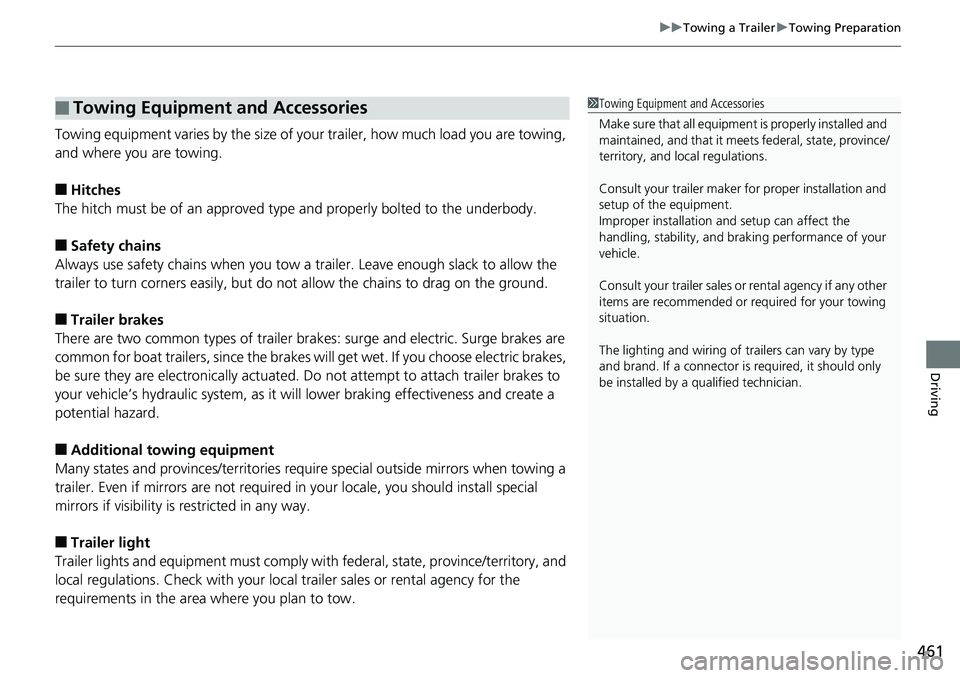
461uu Towing a Trailer u Towing Preparation
Driving
Towing equipment varies by th e size of your trailer, how much load you are towing,
and where you are towing.
■ Hitches
The hitch must be of an approved type and properly bolted to the underbody.
■ Safety chains
Always use safety chains when you tow a trailer. Leave enough slack to allow the
trailer to turn corners easily, but do not allow the chains to drag on the ground.
■ Trailer brakes
There are two common types of trailer bra kes: surge and electric. Surge brakes are
common for boat trailers, since the brakes will get wet. If you choose electric brakes,
be sure they are electronically actuated. Do not attempt to attach trailer brakes to
your vehicle’s hydraulic system, as it wi ll lower braking effectiveness and create a
potential hazard.
■ Additional towing equipment
Many states and provinces/territories requ ire special outside mirrors when towing a
trailer. Even if mirrors are not required in your locale, you should install special
mirrors if visibility is restricted in any way.
■ Trailer light
Trailer lights and equipment must comply with federal, state, province/territory, and
local regulations. Check with your local trailer sales or rent al agency for the
requirements in the area where you plan to tow.■ Towing Equipment and Accessories 1 Towing Equipment and Accessories
Make sure that all equipment is properly installed and
maintained, and that it meets federal, state, province/
territory, and lo cal regulations.
Consult your trai ler maker for prope r installation and
setup of the equipment.
Improper installation and setup can affect the
handling, stability, and br aking performance of your
vehicle.
Consult your traile r sales or rental agency if any other
items are recommended or required for your towing
situation.
The lighting and wiring of tra ilers can vary by type
and brand. If a connector is required, it should only
be installed by a qua lified technician.
Page 464 of 727
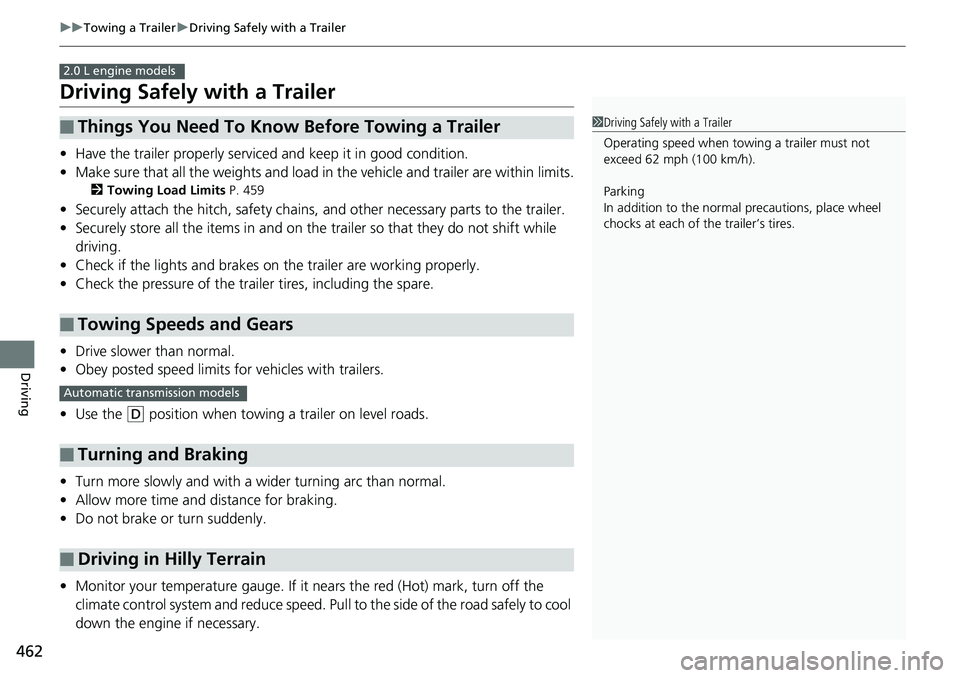
462 uu Towing a Trailer u Driving Safely with a Trailer
Driving Driving Safely with a Trailer • Have the trailer properly serviced and keep it in good condition.
• Make sure that all the weights and load in the vehicle and trailer are within limits.2 Towing Load Limits P. 459
• Securely attach the hitch, safety chains, and other necessary parts to the trailer.
• Securely store all the items in and on the tr ailer so that they do not shift while
driving.
• Check if the lights and brakes on the trailer are working properly.
• Check the pressure of the traile r tires, including the spare.
• Drive slower than normal.
• Obey posted speed limits for vehicles with trailers.
• Use the ( D
position when towing a trailer on level roads.
• Turn more slowly and with a wider turning arc than normal.
• Allow more time and distance for braking.
• Do not brake or turn suddenly.
• Monitor your temperature gauge. If it nears the red (Hot) mark, turn off the
climate control system and reduc e speed. Pull to the side of the road safely to cool
down the engine if necessary.■ Things You Need To Know Before Towing a Trailer
■ Towing Speeds and Gears
■ Turning and Braking
■ Driving in Hilly Terrain 2.0 L engine models
1 Driving Safely with a Trailer
Operating speed when towing a trailer must not
exceed 62 mph (100 km/h).
Parking
In addition to the normal precautions, place wheel
chocks at each of the trailer’s tires.
Automatic transmission models
Page 477 of 727
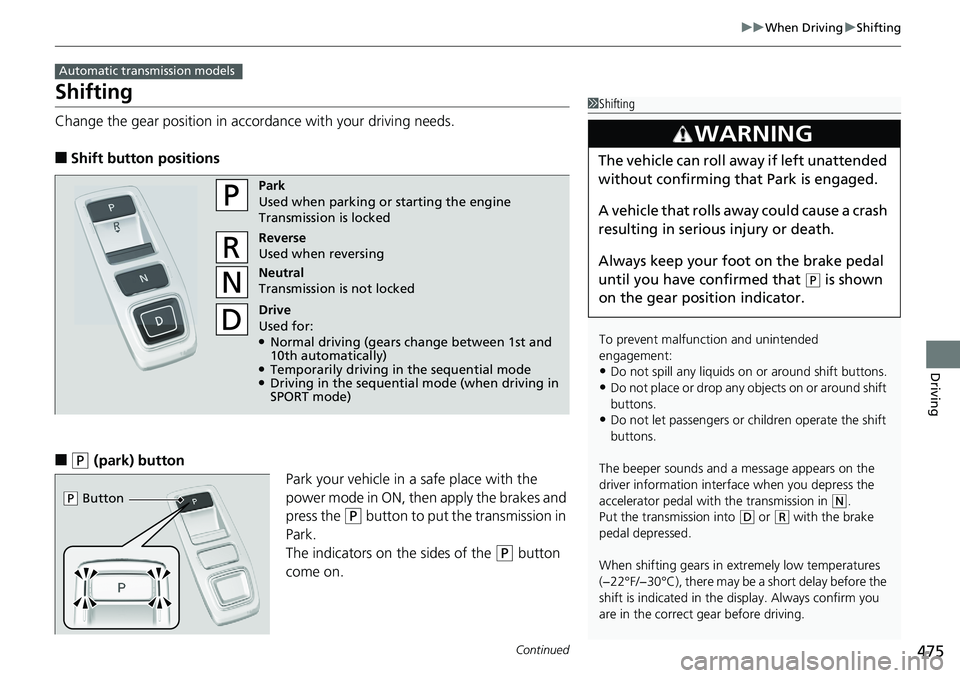
475 uu When Driving u Shifting
Continued
Driving
Shifting Change the gear position in accordance with your driving needs.
■ Shift button positions
■ ( P
(park) button
Park your vehicle in a safe place with the
power mode in ON, then apply the brakes and
press the ( P
button to put the transmission in
Park.
The indicators on the sides of the ( P
button
come on.Automatic transmission models
1 Shifting
To prevent malfunc tion and unintended
engagement:
• Do not spill any liquids on or around shift buttons.
• Do not place or drop any objects on or around shift
buttons.
• Do not let passengers or ch ildren operate the shift
buttons.
The beeper sounds and a message appears on the
driver information interf ace when you depress the
accelerator pedal with the transmission in ( N
.
Put the transmission into ( D
or ( R
with the brake
pedal depressed.
When shifting gears in extremely low temperatures
(−22°F/−30°C), there may be a short delay before the
shift is indicated in the di splay. Always confirm you
are in the correct gear before driving.3
WARNING The vehicle can roll aw ay if left unattended
without confirming that Park is engaged.
A vehicle that rolls away could cause a crash
resulting in serious injury or death.
Always keep your foot on the brake pedal
until you have confirmed that ( P
is shown
on the gear position indicator.Park
Used when parking or starting the engine
Transmission is locked
Reverse
Used when reversing
Neutral
Transmission is not locked
Drive
Used for: ●
Normal driving (gears change between 1st and
10th automatically) ●
Temporarily driving in the sequential mode ●
Driving in the sequential mode (when driving in
SPORT mode)
( P
Button
Page 496 of 727
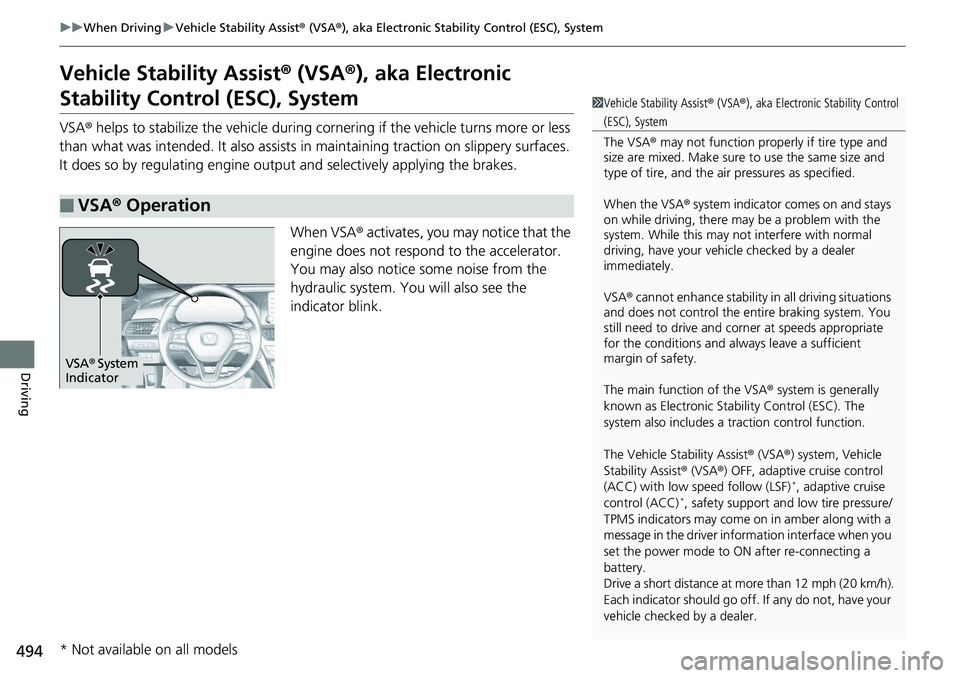
494 uu When Driving u Vehicle Stability Assist ® (VSA ® ), aka Electronic Stability Control (ESC), System
Driving Vehicle Stability Assist ® (VSA ® ), aka Electronic
Stability Control (ESC), System VSA ® helps to stabilize the vehicle during cornering if the vehicle turns more or less
than what was intended. It also assists in maintaining traction on slippery surfaces.
It does so by regulating engine output and select ively applying the brakes.
When VSA ® activates, you may notice that the
engine does not respond to the accelerator.
You may also notice some noise from the
hydraulic system. You will also see the
indicator blink.
■ VSA ® Operation 1 Vehicle Stability Assist ® (VSA ® ), aka Electronic Stability Control
(ESC), System
The VSA ® may not function properl y if tire type and
size are mixed. Make sure to use the same size and
type of tire, and the air pressures as specified.
When the VSA ® system indicator comes on and stays
on while driving, there ma y be a problem with the
system. While this may not interfere with normal
driving, have your vehi cle checked by a dealer
immediately.
VSA ® cannot enhance stability in all driving situations
and does not control the entire braking system. You
still need to drive and corner at speeds appropriate
for the conditions and always leave a sufficient
margin of safety.
The main function of the VSA ® system is generally
known as Electronic Stability Control (ESC). The
system also includes a traction control function.
The Vehicle Stability Assist ® (VSA ® ) system, Vehicle
Stability Assist ® (VSA ® ) OFF, adaptive cruise control
(ACC) with low speed follow (LSF) *
, adaptive cruise
control (ACC) *
, safety support and low tire pressure/
TPMS indicators may come on in amber along with a
message in the driver information interface when you
set the power mode to ON after re-connecting a
battery.
Drive a short distance at more than 12 mph (20 km/h).
Each indicator should go of f. If any do not, have your
vehicle checked by a dealer.VSA ® System
Indicator
* Not available on all models
Page 498 of 727
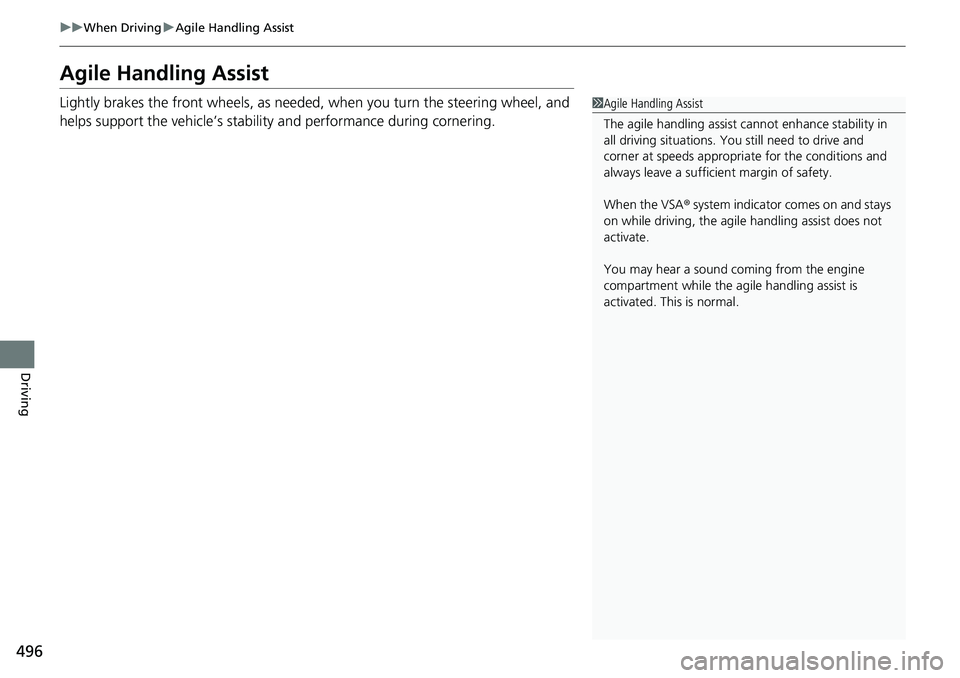
496 uu When Driving u Agile Handling Assist
Driving Agile Handling Assist Lightly brakes the front wheel s, as needed, when you tu rn the steering wheel, and
helps support the vehicle’s stability and performance during cornering. 1 Agile Handling Assist
The agile handling assist ca nnot enhance stability in
all driving situations. You still need to drive and
corner at speeds appropriate for the conditions and
always leave a sufficient margin of safety.
When the VSA ® system indicator comes on and stays
on while driving, the agil e handling assist does not
activate.
You may hear a sound coming from the engine
compartment while the agile handling assist is
activated. This is normal.
Page 513 of 727
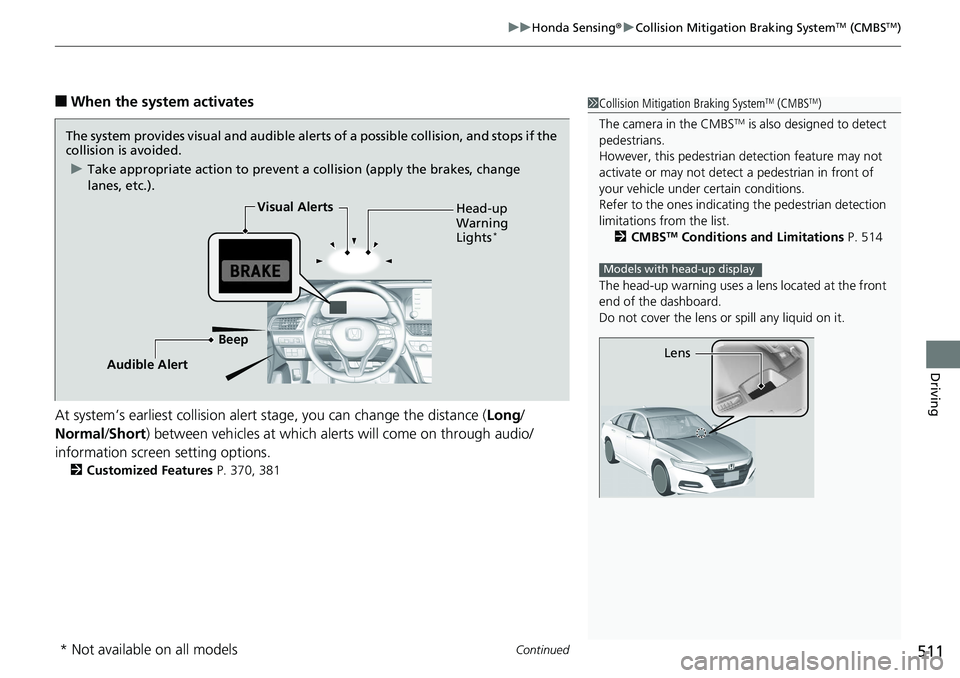
Continued
511uu Honda Sensing ® u Collision Mitigation Braking System TM
(CMBS TM
)
Driving
■ When the system activates
At system’s earliest collision alert st age, you can change the distance ( Long /
Normal / Short ) between vehicles at which alerts will come on through audio/
information screen setting options. 2 Customized Features P. 370, 381 1 Collision Mitigation Braking System TM
(CMBS TM
)
The camera in the CMBS TM
is also designed to detect
pedestrians.
However, this pedestrian detection feature may not
activate or may not detect a pedestrian in front of
your vehicle under certain conditions.
Refer to the ones indicating the pedestrian detection
limitations from the list.
2 CMBS TM
Conditions and Limitations P. 514
The head-up warning uses a lens located at the front
end of the dashboard.
Do not cover the lens or spill any liquid on it.Models with head-up display
LensThe system provides visual and audible alerts of a possible collisi on, and stops if the
collision is avoided.
u Take appropriate action to prevent a collision (apply the brakes, change
lanes, etc.).
Beep Head-up
Warning
Lights *
Visual Alerts
Audible Alert
* Not available on all models
Page 517 of 727
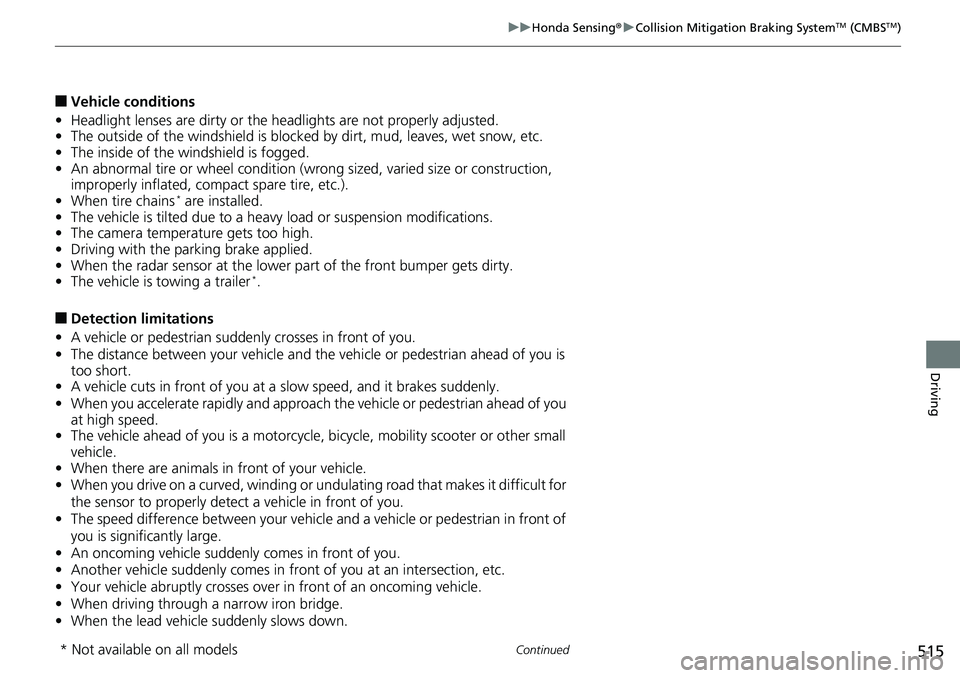
515uu Honda Sensing ® u Collision Mitigation Braking System TM
(CMBS TM
)
Continued
Driving
■ Vehicle conditions
• Headlight lenses are dirty or the h eadlights are not properly adjusted.
• The outside of the windshield is blocked by dirt, mud, leaves, wet snow, etc.
• The inside of the windshield is fogged.
• An abnormal tire or wheel condition (wro ng sized, varied size or construction,
improperly inflated, co mpact spare tire, etc.).
• When tire chains *
are installed.
• The vehicle is tilted du e to a heavy load or suspension modifications.
• The camera temperature gets too high.
• Driving with the parking brake applied.
• When the radar sensor at the lower part of the front bumper gets dirty.
• The vehicle is towing a trailer *
.
■ Detection limitations
• A vehicle or pedestrian suddenly crosses in front of you.
• The distance between your vehicle and the vehicle or pedestrian ahead of you is
too short.
• A vehicle cuts in front of you at a slow speed, and it brakes suddenly.
• When you accelerate rapidly and approach the vehicle or pedestrian ahead of you
at high speed.
• The vehicle ahead of you is a motorcycle, bicycle, mobility scooter or other small
vehicle.
• When there are animals in front of your vehicle.
• When you drive on a curved, winding or und ulating road that makes it difficult for
the sensor to properly detect a vehicle in front of you.
• The speed difference between your vehicle an d a vehicle or pedestrian in front of
you is significantly large.
• An oncoming vehicle suddenly comes in front of you.
• Another vehicle suddenly comes in fr ont of you at an intersection, etc.
• Your vehicle abruptly crosses over in front of an oncoming vehicle.
• When driving through a narrow iron bridge.
• When the lead vehicle suddenly slows down.
* Not available on all models
Page 521 of 727
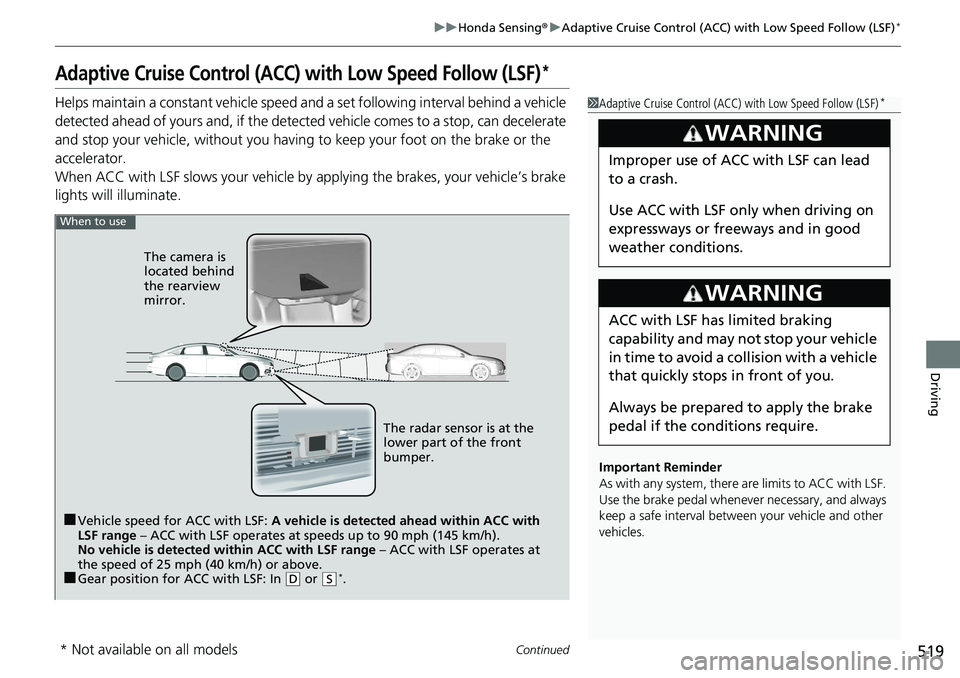
519uu Honda Sensing ® u Adaptive Cruise Control (ACC) with Low Speed Follow (LSF) *
Continued
Driving
Adaptive Cruise Control (ACC) with Low Speed Follow (LSF) *Helps maintain a constant vehicle speed and a set following interval behind a vehicle
detected ahead of yours and, if the detect ed vehicle comes to a stop, can decelerate
and stop your ve hicle, without you having to keep your foot on the brake or the
accelerator.
When ACC with LSF slows your vehicle by applying the brakes, your vehicle’s brake
lights will illuminate. 1 Adaptive Cruise Control (ACC) with Low Speed Follow (LSF) *
Important Reminder
As with any system, there are limits to ACC with LSF.
Use the brake pedal whenever necessary, and always
keep a safe interval betw een your vehicle and other
vehicles.3
WARNING Improper use of ACC with LSF can lead
to a crash.
Use ACC with LSF only when driving on
expressways or freeways and in good
weather conditions.
3
WARNING ACC with LSF has limited braking
capability and may not stop your vehicle
in time to avoid a co llision with a vehicle
that quickly stops in front of you.
Always be prepared to apply the brake
pedal if the cond itions require.When to use
■ Vehicle speed for ACC with LSF: A vehicle is detected ahead within ACC with
LSF range – ACC with LSF operates at speeds up to 90 mph (145 km/h).
No vehicle is detected within ACC with LSF range – ACC with LSF operates at
the speed of 25 mph (40 km/h) or above.
■ Gear position for ACC with LSF: In ( D
or ( S *
. The radar sensor is at the
lower part of the front
bumper.The camera is
located behind
the rearview
mirror.
* Not available on all models